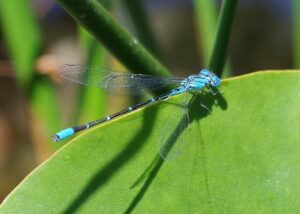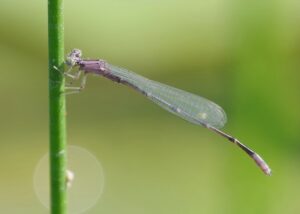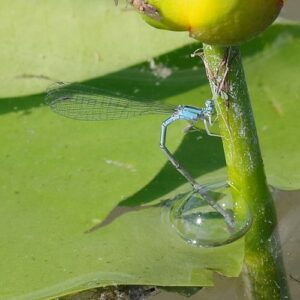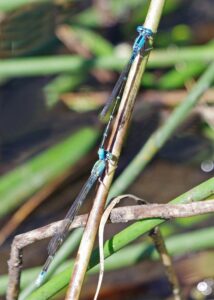Note: Most link leaves to external sites.
Howdy, BugFans,
Back in the summer of 2019, in an episode about Lilypad Forktail damselflies entitled “A Species on the March,” the BugLady wrote, “Lake Twelve is famous because of the presence there of not one, but two rare (in Wisconsin) damselflies – the Slender Bluet and the Lilypad Forktail. The bluet has been on and off of our state radar since 2007; the forktail was first recorded at Lake Twelve in 2017 but has been seen intermittently in Wisconsin since 2010.”
The property on the west end of Lake Twelve is part of the Biehl Nature Preserve, one of the Ozaukee Washington Land Trust preserves, and along with these two species, there are lots of other dragons and damsels around (the pier is often partly submerged, so dress accordingly).
This is the story of the Slender Bluet.
Bluets are members of the Pond or Narrow-winged damselfly family Coenagrionidae – with 105 species, it’s the most common damselfly family. In Wisconsin, the family includes the bluets, dancers, forktails, and sprites, and the (enigmatic) Eastern Red Damsel. The Pond Damsels are a colorful bunch, with males more vivid than females. Adults tend to perch near the ground (routinely below the BugLady’s knee level), and they fold their wings over their abdomen when they perch. Various species of Pond damsels are in the air from late spring to late summer – they (mostly) aren’t long-distance flyers, and males are not territorial. Some species overwinter as eggs and others as naiads, and they are tolerant of cold and freezing at the north end of their range.
A study of the naiads of a New Zealand Pond damsel revealed an array of body language used by the naiads to communicate predation threat, competition, and territorial behavior.
Canadian Naturalist John Acorn calls bluets “floating neon toothpicks.” The American bluets are all in the genus Enallagma, but we also have a few species of Eurasian bluets in the cosmopolitan genus Coenagrion. Most male bluets have bodies that are blue and black in varying proportions – for “ease” in identification, they are artificially divided into the “black-type” bluets, the “intermediate-type” bluets, and the “blue-type” bluets. Females are a different ballgame – they are not brightly-colored, and while some species have identifying markings, others enjoy different color phases, and their ID is often up for grabs. Unless you have a hand lens. And, alas, some of the dancers look bluet-ish, too.
For their aquatic naiads bluets choose unpolluted still or slowly moving water with plenty of submerged vegetation. Eggs are inserted into plant stems and the naiads (categorized as “engulfing predators”) climb around among the plants and ambush their prey, which includes any aquatic critter smaller than they are.
Slender Bluets (Enallagma traviatum) aren’t from around here, historically. The species is divided into two subspecies; one (Enallagma traviatum traviatum) occurs on the east side of the Alleghenies/Appalachians and the other, Westfall’s Slender Bluet (Enallagma traviatum westfalli) on the west. It is an Eastern, or maybe Southeastern, species that is moving west and north – an account from Vermont, where it was first seen in 2001, called it “another southern species that may be expanding into our region.” It was first recorded in Wisconsin in 2007, and since then there have been 70 reports from just a few locations in about 20 counties in Wisconsin, with sightings getting more numerous in the past three years (thank you, lovely, searchable Wisconsin Odonata Survey database. Its status is listed by the Wisconsin Natural History Inventory as Critically imperiled/Vulnerable due to its restricted range and relatively few populations – understandable in an animal that’s in the early days of establishing itself here. Among dragonfly enthusiasts, it’s listed as a “Most Wanted” species.
This is a beautiful, “black-type” bluet whose blue is a striking sky-blue (except for the lilac-hued tenerals (juveniles). Males have a wide, black stripe on the dorsal side of their abdomen, and in females that stripe is interrupted by a slim, blue line down the middle. They’re about 1 ¼” long, and they have very large, very blue eyespots/postocular spots – pigmented patches on the tops of their eyes. The male’s claspers are described as “pistol-shaped” (along with a few other features, eyespots and claspers are used in identifying bluets). Here’s a nice set of pictures.
Look for them from mid-June through July in Wisconsin. Robert DuBois, in Damselflies of Minnesota, Wisconsin & Michigan (the successor to Damselflies of the North Woods) tells us that “males frequently hover over open water, sometimes while in tandem with the female” and that “oviposition usually occurs into vegetation at the water’s surface with male contact-guarding in sentinel position, but female sometimes descends alone to oviposit into plant stems.” Bugguide.net says that “Tandem pairs will gather by the dozens perched on stems above the water or staking claims out over floating vegetation,” and the BugLady found numerous pictures of Slender Bluets ovipositing alongside other Slender Bluets, reminiscent of Powdered Dancers. Like the other bluets of our area, they overwinter as naiads.
When they pick a spot to oviposit, some Odonates (dragons and damsels) avoid bodies of water that contain fish, but Slender Bluet naiads can be found in fishy waters. The naiads have been subjects in a number of experiments designed to gauge the survival of naiads whose main predators are fish (bluegills) vs those that are preyed on by the hefty naiads of Common Green Darner dragonflies. Some experiments compared Slender Bluet naiads with those of Azure Bluets, and others compared Slender Bluets with forktail naiads.
Some outtakes:
- With some overlap, one set of bluet species lives in ponds with fish; and ponds without fish support a different set.
- The presence of fish inhibits feeding excursions by damselfly naiads.
- Naiads from fishless ponds move quickly and conspicuously; naiads from fishy lakes (like the Slender Bluet) and from fishless lakes with darner naiads move slowly and are more hidden.
- Bluet naiads from fishy lakes, including Slender Bluets, tend to ignore darner naiads – and often get eaten by them.
- When predaceous fish are around, the species composition of a pond community favors species that are harder to find.
The BugLady was curious about the species name traviatum, but her digging didn’t get her very far. She couldn’t find a meaning for “traviatum,” so she looked up “traviata” and got lots of references to the opera, plus a few baby-naming sites that informed her that Traviata means “corrupted” or “led astray” (and so, is an unlikely candidate for inclusion on future “10 Most Popular Girls’ Names” list).
*BOTW will not appear on February 7 but will be back in action on February 14. *
The BugLady



